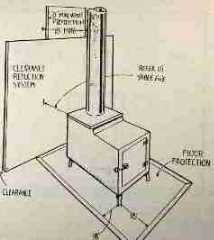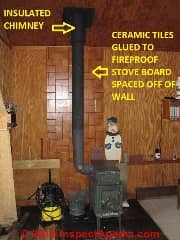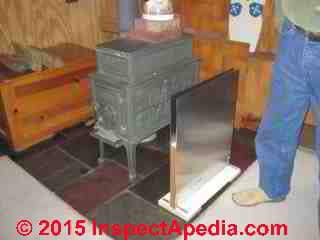 Wood Stove Heat shields
Wood Stove Heat shields
Fire clearance distance reduction using heat shields
- POST a QUESTION or COMMENT about fire safety clearances for woodstoves and coal stoves
Woodstove heat shields & fire clearances:
What fire clearance reduction can you obtain by adding an approved heat shield at a wood stove or pellet stove?
Does the manufacturer permit heat shields? Heat shield codes.
This article series describes fire safety distances required between wood stoves and coal stoves and the nearest combustible surface.
InspectAPedia tolerates no conflicts of interest. We have no relationship with advertisers, products, or services discussed at this website.
Heat Shield Specifications for Wood Stoves & Pellet Stoves
 The tan ceramic tile heat shield behind the woodstove and its flue in this photo was constructed by the author [DF] in 1990 by bonding ceramic tile to a factory-made fireproof heat shield board consisting of metal covering a fireproof cement board.
The tan ceramic tile heat shield behind the woodstove and its flue in this photo was constructed by the author [DF] in 1990 by bonding ceramic tile to a factory-made fireproof heat shield board consisting of metal covering a fireproof cement board.
[Click to enlarge any image]
Key to making this heat shield "work" safely is the provision of un-obstructed air flow around all four sides of the shield and an adequate spacing (about 2" in this case") off of the combustible wall that it protects.
We took care as well to use insulating mounts between the heat shield and the wall behind so that the connectors themselves don't form a heat conducting path between the wood stove and the combustible wall.
There are two approaches to heat shield protection to reduce wood heater fire clearance distances
- A heat shield is attached to the wood heater itself:
CSA Standard B365-1991 Table 3 p. 26 in discussing clearances for un-certified heaters specifies:
Shielding consists of protection such as external jacketing or metal heat shield attached to the sides and rear of the appliance and spaced out at least 50 mm (2 inches) by non-combustible spacers, with a provision for air circulation at bottom and top. - A heat shield is attached to nearby walls or ceilings
such as mine shown in the photo.
Wall-mounted Heat Shield Protection:
A proper non-combustible fire-protective barrier for a wall-mounted includes a 1" air space between the barrier and the combustible wall.
Mounting hardware for heat shields:
The non-combustible wall protection must use insulating and non-combustible mounting hardware that can not conduct heat from the woodstove or its flue to the combustible wall through the barrier.
Air circulation behind heat shields:
If air cannot circulate freely behind the noncombustible wall protection the installation is unsafe and not acceptable. Most standards specify one-inch or in some cases 7/8" of air space behind the heat shield. Some standards specify a 2" air space.
Watch out: Check with your local fire marshall about local building code requirements for fire-clearance distances before installing and using a wood stove, coal stove, or other auxiliary heat source. Making a mistake can lead to a dangerous building fire.
Watch out: providing an air space may be inadequate fire protection if air cannot circulate freely behind the heat shield. Avoid blocking the openings at the top or bottom a heat shield.
Percentage Woodstove Clearance Distance Reductions By Use of a Heat Shield
 at left is a Jotul woodstove that I (DF) traded to Paul Galow for a fancy wristwatch.
at left is a Jotul woodstove that I (DF) traded to Paul Galow for a fancy wristwatch.
Paul installed air-spaced heat shields of ceramic tile mounted on fireproof board behind the stove and he added a heat shield (the silver contraption) on the side of the stove facing a bed just to slow down the heat in that direction.
More about this wood stove is
That wood-box on the left side of the stove is a bit close in my OPINION.
And the heat shield, really intended as a heat reflector to avoid overheating Mr. Galow's leg (shown in the photo) is itself constructed using a melange of reflective metal and combustible wood as a spacer and as a foot stand.
Watch out: as I've warned Paul, Even if no immediate fire or smoking wall is observed, use of a wood or other heating appliance too close to combustibles can lower their combustion point so that years later during use of the same appliance under what seem to be the same conditions, a fire may occur.
See PYROLYSIS EXPLAINED for details.
In my OPINION this is not a safe heat shield. Like many wood stove users, P.G., the owner has chosen to exercise caution and attention for more complete and effective heat shielding - an approach that we've seen successful until a new, less informed or less cautious occupant uses the installation.
According to Wood Heat Safety Woodheat.org Original source: http://www.woodheat.org/clearances.html
- Sheet metal heat shield, 29 gauge or heavier, with 7/8" (we recommend 1") air space (described below):
- Reduce side & rear clearances by 67%
- Reduce top clearance distance by 50%
- Non-combustible heat shield such as ceramic tile or equivalent, with 7/8" (we recommend 1") air space (described below):
- Reduce side & rear clearances by 50%
- Reduce top clearance distance by 33%
- Combined non-combustible heat shield as in #2 above, mounted on sheet metal backing as in #1 above. [You can see our combined sheet metal, noncombustible cement backer board and ceramic tile heat shield with air space in the photo at above left]
- Reduce side & rear clearances by 67%
- Reduce top clearance distance by 50%
- Brick heat shield at wall(s) with 7/8" air space between heat shield & wall
- Reduce side & rear clearances by 50%
- Brick heat shield with metal backing (as above) with 7/8" air space as above
- Reduce side & rear clearances by 67%
- Woodheat.org Ret: 11/16/2014 Original source: http://www.woodheat.org/clearances.html
Reader Comments, Questions & Answers About The Article Above
Below you will find questions and answers previously posted on this page at its page bottom reader comment box.
Reader Q&A - also see RECOMMENDED ARTICLES & FAQs
On 2019-10-15 by (mod) - How high above the woodstove top surface do I need to install the shield?
Darrell
It's a great question but - sorry - I don't know enough of the setup to offer much useful opinion except to say that you want
1. any combustible materials, including walls, ceilings, floors, that are NOT protected by the heat shield to meet the fire clearance distances specified by the manufacturer for the stove - typically 36". You can make measurements from the woodstove's top surface as well as its flue vent connector to its chimney accordingly.
2. Assure that the construction and materials of the heat shield AND the actual reduction in clearances are accepted by the woodstove manufacturer and your local fire inspector.
Keep in mind that a mistake such as using heat-conducting fasteners or blocking air flow around and behind the heat shield can reduce its effectiveness.
On 2019-10-15 by Darrell
I'm in the processing of installing a heatshield around a certified woodstove. I'll be installing the stove 6 inches from the shield, reducing the manufacturer's nameplate from 11 inches. My question, How high above the woodstove top surface do I need to install the shield?
On 2019-08-26 by (mod) -
Construction is filled with people who express vehement opinion, are very confident, and who have not even read the manufacturer's instructions. I trust the manufacturer first.
On 2019-08-26 by Kev
Thanks Dan, The stovepipe is definitely double walled certified for 6" clearance to combustibles (I can see that on the label) and the shield attached to the stovepipe by metal spacers says it can reduce the stovepipe clearance from 18" to 9" (again, noted on the label for that piece). I'm not sure why the 'expert' believes that this same shield can reduce a 6" clearance to a 2" clearance. I'll consult with the stovepipe manufacturer and see if they agree.
On 2019-08-18 by (mod) - a heat shield can often reduce the required clearance from combustibles. BUT
Thanks for asking, Kev.
In general, provided it's approved by your local fire inspector, a heat shield can often reduce the required clearance from combustibles. BUT
No one with any sense is going to bet your life and money by claiming that any fire-safety installation is proper and safe by a brief e-text.
I'd start, Kev, with identifying the brand and specific product double wall pipe, the fuel being burned, and the fire safety of the whole installation.
Armed with actual information, it ought to be easy, then to ask both the stovepipe manufacturer AND the manufacturer of the heater that you're venting if they agree that the heat shield will be adequate and to ask for very specific installation details: spacer materials, shield materials, fasteners, air spacing around all sides of the heat shield, etc.
On 2019-08-15 by Kev
We have an 'expert' claiming that I can add a stovepipe shield to an existing double-wall pipe in order to reduce the clearance from 6" to 2" (I only have 4" of clearance to the wall currently). Is this accurate? I can find documentation addressing single walled pipes and shields but nothing about a double walled pipe
On 2019-08-09 by (mod) -
Regarding your worry that when air conditioning is working metals on the wall behind the pellet stove will collect condensation and cause a mold problem, that's theoretically possible but in my view extremely doubtful.
the air conditioning system, properly sized, REDUCES indoor humidity level so you won't see condensation on indoor surfaces - if you do then something's wrong with the building (leaks for example) or with the air conditioner (over-sized for example)
On 2019-08-09 by (mod) - get air circulation behind the heat shield
Paula Marie:
To get air space for circulation and cooling behind a tile surface we glued our ceramic tiles to a fireproof stove-board (a metal-covered fireproof cement board). The board was first mounted to the wall using 1 1/2" stand-offs - essentially small metal tubes that acted as spacers, though a non-heat-conducting stand-off would have been technically more correct and more safe.
The stove board was spaced 2" off of the floor, 1 1/2" off of the wall, and had several feet of clearance at either side and at the top so that air can circulate freely behind the board (by convection).
Then we glued our ceramic tile to the stove-board to form an attractive surface.
In the photo you can see the brown ceramic tile extending from just above the floor to just below the ceiling;
Projecting down from the ceiling about two feet is an insulated metal chimney - reducing the remaining fire hazard at that small amount of wood wall exposed at the top of the ceramic tile heat shield as well as around the wood ceiling where it's penetrated by the chimney.

On 2019-08-07 by Anonymous
One more sorry...I heard that if you air-condition your home in the summer and it it super cool, certain metals used on the wall behind the pellet stove can cause concentration and eventually mold spores etc. is this true and if so is there something we can do to avoid this?
On 2019-08-07 by Paula Marie
How does one get air space between the wall and ceramic tiles?
Also, where do I go to see options to purchase for my wall behind our pellet stove?
Last question, I have a farmers porch and our vent comes out the side of our house and I noticed that the unfinished part under the roof has a black sooty look to it and I think it may have something to do with the vent as
I occasionally see sparks coming out (outside) when in use and it scares me...my question is what can we do to make that safer...can I put up some sort of metal above the area of the vent? Thanks for your help.
On 2019-01-27 by (mod) -
Ross: I haven't seen reliable engineering calculations but certainly more distance is better;
In general, Air (before considering the effects of circulation) has an R-value of about 1.01 for three inches of space.
So if you go from one-inch (about R 0.33) to 6 inches of air space (about R 2.02) you've increased the R-value of the space 6 times.
Watch out: since air circulation through the air gap is very important, just increasing the heat shield distance from a wall, say, without assuring that there is free air flow in the space, may give a false and improper sense of fire safety.
However what's critical in reducing a fire hazard is not just distance between the heat shield and the protected surface but also
- the ability of air to circulate behind the heat shield
- the distance on the hot side of the heat shield, between the shield and the wood stove or other heat source
- the temperatures in and around the woodstove
- the properties of the combustible material being protected
- the possible effects of pyrolysis on combustible materials that have been heated over protracted intervals or over many years
On 2019-01-27 by Ross Manes
Does anyone address the effect of putting a heat shield more than one inch, let's say six inches, from a combustible wall?
...
Continue reading at FIRE CLEARANCES, WOOD COAL & PELLET STOVES - topic home, or select a topic from the closely-related articles below, or see the complete ARTICLE INDEX.
Or see these
Recommended Articles
- FIRE CLEARANCES INDOORS
- FIRE CLEARANCES, MASONRY CHIMNEYS
- FIRE CLEARANCES, METAL CHIMNEYS
- FIRE CLEARANCES, WOOD COAL & PELLET STOVES
- HEAT SHIELD SPECIFICATIONS for WOOD STOVES & PELLET STOVES
- PELLET STOVE CLEARANCE DISTANCES
- PYROLYSIS EXPLAINED
- WOOD-OIL COMBINATION HEATERS
- WOOD STOVE OPERATION & SAFETY - home
- COMBUSTION AIR for WOODSTOVES
- DEFECTS LIST - HEAT, WOOD APPLIANCE
- FIRE CLEARANCES, WOOD COAL & PELLET STOVES
- FIREPLACE INSERTS INSTALL, INSPECT, REPAIR
- HEAT SHIELD SPECIFICATIONS for WOOD STOVES & PELLET STOVES
- PELLET STOVE CLEARANCE DISTANCES
- PELLET STOVE DRAFT CONTROL
- PELLET STOVE MANUALS
- WOOD FURNACE FAN LIMIT CONTROL
- WOODSTOVE DRAFT CONTROL
- WOOD STOVE DRAFT TEST
- WOOD STOVE, CATALYTIC PUFF-BACKS
- WOOD STOVE INSTALL CONVERT
- WOOD STOVE INSPECTION CHECKLIST [PDF]
- WOOD STOVE MANUALS
Suggested citation for this web page
HEAT SHIELD SPECIFICATIONS for WOOD STOVES & PELLET STOVES at InspectApedia.com - online encyclopedia of building & environmental inspection, testing, diagnosis, repair, & problem prevention advice.
Or see this
INDEX to RELATED ARTICLES: ARTICLE INDEX to CHIMNEYS & FLUES
Or use the SEARCH BOX found below to Ask a Question or Search InspectApedia
Ask a Question or Search InspectApedia
Try the search box just below, or if you prefer, post a question or comment in the Comments box below and we will respond promptly.
Search the InspectApedia website
Note: appearance of your Comment below may be delayed: if your comment contains an image, photograph, web link, or text that looks to the software as if it might be a web link, your posting will appear after it has been approved by a moderator. Apologies for the delay.
Only one image can be added per comment but you can post as many comments, and therefore images, as you like.
You will not receive a notification when a response to your question has been posted.
Please bookmark this page to make it easy for you to check back for our response.
Our Comment Box is provided by Countable Web Productions countable.ca
Citations & References
In addition to any citations in the article above, a full list is available on request.
- Travis Industries, "36 Elite Installation Manual, Wood-Burning Zero-Clearance Fireplace", Travis Industries House of Fire, 4800 Harbour Pointe Blvd. SW, Mukilteo, WA 98275, (2010), Website: http://www.travisindustries.com/ - retrieved 12/1/2014, original source: http://www.fireplacex.com/TravisDocs/93508090.pdf. This wood burning zero clearance fireplace was tested and listed by Omni Test Laboratories, Beaverton OR, Report # 028-F-60-4, meeting U.L. 127 & portions of UL 1482 & 907.
- In addition to citations & references found in this article, see the research citations given at the end of the related articles found at our suggested
CONTINUE READING or RECOMMENDED ARTICLES.
- Carson, Dunlop & Associates Ltd., 120 Carlton Street Suite 407, Toronto ON M5A 4K2. Tel: (416) 964-9415 1-800-268-7070 Email: info@carsondunlop.com. Alan Carson is a past president of ASHI, the American Society of Home Inspectors.
Thanks to Alan Carson and Bob Dunlop, for permission for InspectAPedia to use text excerpts from The HOME REFERENCE BOOK - the Encyclopedia of Homes and to use illustrations from The ILLUSTRATED HOME .
Carson Dunlop Associates provides extensive home inspection education and report writing material. In gratitude we provide links to tsome Carson Dunlop Associates products and services.

